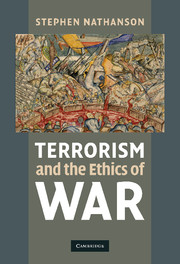Book contents
- Frontmatter
- Contents
- Acknowledgments
- Introduction
- PART I TERRORISM: WHAT'S IN A NAME?
- PART II WHY MORAL CONDEMNATIONS OF TERRORISM LACK CREDIBILITY
- Introduction: toward morally credible condemnations of terrorism
- 6 Why standard theories fail to condemn terrorism
- 7 Just war theory and the problem of collateral damage
- Conclusion: categorical vs. conditional criticisms of terrorism
- PART III DEFENDING NONCOMBATANT IMMUNITY
- PART IV HOW MUCH IMMUNITY SHOULD NONCOMBATANTS HAVE?
- Conclusion: terrorism and the ethics of war
- Bibliography
- Index
7 - Just war theory and the problem of collateral damage
Published online by Cambridge University Press: 05 June 2012
- Frontmatter
- Contents
- Acknowledgments
- Introduction
- PART I TERRORISM: WHAT'S IN A NAME?
- PART II WHY MORAL CONDEMNATIONS OF TERRORISM LACK CREDIBILITY
- Introduction: toward morally credible condemnations of terrorism
- 6 Why standard theories fail to condemn terrorism
- 7 Just war theory and the problem of collateral damage
- Conclusion: categorical vs. conditional criticisms of terrorism
- PART III DEFENDING NONCOMBATANT IMMUNITY
- PART IV HOW MUCH IMMUNITY SHOULD NONCOMBATANTS HAVE?
- Conclusion: terrorism and the ethics of war
- Bibliography
- Index
Summary
Just war theorists share some ideas but differ among themselves on many issues. I will focus on a version of just war theory that prohibits all intentional attacks on civilians and thus condemns all terrorist acts. If we are looking for a view that credibly condemns all terrorism, then this form of just war theory is superior to realism, commonsense morality, (act) utilitarianism, and Walzer's view. Nonetheless, it, too, fails to provide sufficient support for noncombatant immunity, and, because of this, its condemnation of terrorism also lacks credibility.
A BRIEF OVERVIEW OF JUST WAR THEORY
Just war theory has two parts. The first part – jus ad bellum – answers the question “under what conditions is a nation or other group morally justified in going to war?” It does this by providing a set of criteria for judging when going to war is morally justified. Among the criteria that are generally cited are having a just cause, legitimate authority to fight a war, reasonable probability of success, fighting as a last resort, and having a cause for fighting that is weighty enough to make war a proportionate response.
The second part of just war theory – jus in bello – answers the question “what means of fighting a war are morally permissible?” It contains two principles: discrimination and proportionality. The principle of discrimination requires people fighting a war to distinguish soldiers from civilians, and it prohibits attacks on civilians.
- Type
- Chapter
- Information
- Terrorism and the Ethics of War , pp. 94 - 103Publisher: Cambridge University PressPrint publication year: 2010



